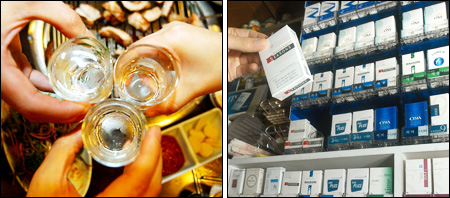Alcohol, tobacco and wealth

People toast with soju over barbecued meat, left photo. Koreans are drinking more soju, distilled rice liquor, shunning high-priced whisky amid the current economic downturn. In the right photo, a sales clerk picks a pack of cigarettes from a display counter. The latest report released by Statistics Korea shows there has been no significant shift in tobacco and alcohol expenditure in the top 20 percent and bottom 20 percent of income brackets.
Income gap hardly affects consumption of ‘sin products’
The conventional wisdom holds that if you earn more, you will spend more on alcohol and cigarettes as economists rationalize they are non-essential goods. But this often turns out to not be the case.
According to the latest report on household consumption patterns by Statistics Korea, there is no significant difference in alcohol and tobacco expenditure between the top 20-percent income bracket and the bottom 20-percent.
The statistical office said the richest one-fifth of households spent an average of 28,400 won a month on cigarettes and alcohol in the first quarter of the year, 1.4 times the 20,400 won spent by an average family in the lowest fifth.
But rich households earned 6.7 times more than poor ones. From January to March, the top 20-percent brought home a monthly average of 8.18 million won, while the bottom 20-percent earned 1.21 million won on average.
Given the significant income disparity between the two groups, the spending gap on cigarettes and alcohol was not meaningful, observers point out.
This is in stark contrast to educational expenses with the top 20 percent spending 668,500 won on average during the January-March period, up to 6.8 times the 97,800 won for the bottom bracket.
Meanwhile, Statistics Korea said middle-income households spent the largest amount of money on alcohol and cigarettes. The top 21 to 40 percent of families by income spent 30,100 won worth per month on average, while those belonging to the 41 to 60 percent group shelled out an average of 30,700 won for the items.
Koreans drink cheaper alcohol
Koreans usually consume more low-priced soju, a traditional distilled liquor, while expensive whiskeys and other premium spirits are avoided amid the continued economic slump.
That seems to have played a role in reducing the expenditure gap of people on the so-called “sin products,’’ which include alcohol and tobacco.
According to the Korea Alcohol Liquor Industry Association (KALIA), local soju makers shipped 315,720 kiloliters in the first quarter, up 4.2 percent from 302,949 kiloliters during the same period last year.
Domestic brewers distributed 384,608 kiloliters of beer in the first three months of the year, down 3.1 percent from 397,126 kiloliters. Also, 566 kiloliters of whiskeys and 4,288 kiloliters of wine were sold to bars or consumers, down 43.8 percent and 21 percent, respectively.
Industry watchers say local consumers have opted to drink soju over high-priced whiskeys to deal with the soaring prices of various goods and services. Slowing income growth has also made households tighten their purse strings and become reluctant to buy expensive items.
They say sluggish beer sales are largely attributed to seasonal factors such as the prolonged cold spell gripping the nation longer than in previous years.
A KALIA spokesman said that beer consumption will increase in the second quarter in a run up to the peak summer season.
“The summer is forecast to be hotter than previous years, which will provide a boost to brewers. Additionally, the surging popularity of baseball will increase beer sales among fans at stadiums or nearby bars following the games,’’ he said.
But he painted a bleak picture for makers of whisky and other hard liquor. “Koreans have become more health conscious. It means they drink less and when they drink, they prefer mild alcoholic beverages.’’
The spokesman also said drinkers used to mix beer with whisky to make boilermakers. “But these days, most people tend to mix beer with soju, not whisky, because it is cheaper and better for their health.’’
He said even though whisky makers introduce new products and launch aggressive marketing campaigns to boost the sales of hard liquor, sales will likely continue to head downward in the foreseeable future. <Korea Times/Lee Hyo-sik>

























































